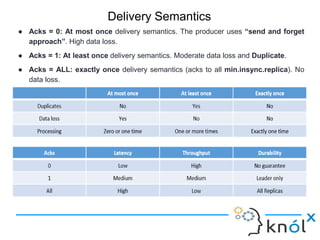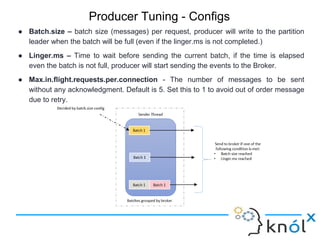Kafka: Internals
- 1. Presented By: Kafka: Internals Sourabh Verma Software Consultant
- 2. Agenda ● Brief Introduction to Kafka - it’s need? ● Key Terminologies - Zookeeper, Broker, Topic, Partitions, Offsets, and Replication. ● IT Team and Kafka Cluster Analogy. ● Summarize the Core components and responsibilities. ● Kafka Tuning: Availability & Consistency. ● Delivery Semantics. ● Producer Tuning - Configs. (BONUS) ● DEMO
- 3. Brief Introduction to Kafka - it’s need? ● Kafka is a horizontally scalable, fault tolerant, and fast messaging system. It’s a pub- sub model in which various producers and consumers can write and read. It decouples source and target systems. Few Use Cases: ● Scale to hundreds of nodes. ● Can handle millions of messages per second. ● Real-time processing (~10ms).
- 4. Key Terminologies ● ZooKeeper is a centralized service for managing distributed systems. It acts as ensemble layer (ties things together) and ensures high availability of the Kafka cluster. ● ZooKeeper stores metadata and the current state of the Kafka cluster. For example, details like topic name, the number of partitions, replication, leader details of partition, and In-Sync Replicas are stored in ZooKeeper. (After Kafka 0.10, consumer offsets are not stored in ZooKeeper). ● Broker is a single Kafka node that is managed by ZooKeeper. A set of brokers form a Kafka cluster. Topics that are created in Kafka are distributed across brokers based on the partition, replication, and other factors. Note: When a broker node fails based on the state stored in ZooKeeper it automatically rebalances the cluster and if a leader partition is lost then one of the follower partition (ISR) is elected as the leader. ● Topic is a specific stream of data. It is very similar to a table in a NoSQL database. Like tables in a NoSQL database, the topic is split into partitions that enable topics to be distributed across various nodes. Like primary keys in tables, topics have offsets per partitions. You can uniquely identify a message using its topic, partition, and offset.
- 5. Key Terminologies ● Partitions enable topics to be distributed across the cluster. Partitions are a unit of parallelism for horizontal scalability. One topic can have more than one partition scaling across nodes. Messages are assigned to partitions based on partition keys, if there are no partition keys then the partition is randomly assigned. It’s important to use the correct key to avoid hotspots. ● Offsets - Each message in a partition is assigned an incremental id called an offset. Offsets are unique per partition and messages are ordered only within a partition. Messages written to partitions are immutable. Note: Messages are not ordered between multiple partitions.
- 6. Key Terminologies ● Replication is making a copy of a partition available in another broker. Replication enables Kafka to be fault tolerant. When a partition of the topic is available in multiple brokers then one of the partitions in a broker is elected as the leader and the rest of the replications of the partition are followers. ● Replication enables Kafka to be fault tolerant even when a broker is down, the partition from another broker is elected as a leader and it starts serving the producers and consumer groups. Replica partitions that are in sync with the leader are flagged as ISR (In Sync Replica).
- 7. IT Team and Kafka Cluster Analogy.
- 8. Summarize the Core components and responsibilities. ● ZooKeeper manages Kafka brokers and their metadata. ● Brokers are horizontally scalable Kafka nodes that contain topics and it's replications. ● Topics are message streams with one or more partitions. ● Partitions contains messages with unique offsets per partition. ● Replication enables Kafka to be fault tolerant using follower partitions (ISRs).
- 9. Kafka Tuning: Availability & Consistency ● Cluster Size (N): Number of nodes/brokers in the Kafka cluster, we should have 2x+1, i.e. at least 3 nodes or more in an odd number. ● Partitions: Topic is divided into partitions (by default 1), but we should have M times N, where M can be any integer number, i.e. M >= 1, to achieve more parallelism and partitioning of data over the cluster. (only if order is not a concern.) ● Replication Factor: determines the number of copies (including the original/Leader) of each partition in the cluster. All replicas of a partition exist on separate node/broker, and we should never have R.F. > N, but at least 3. We recommend having 3 RF with 3 or 5 nodes cluster. This helps in having both availabilities as well as consistency. ● In-sync Replica (ISR): Number of minimum replicas (including the leader) synced up, i.e. available for the producer to successfully send messages to the partition. This inversely impacts the availability for producer i.e. lower the ISR more the availability and lesser the consistency and vice versa. we should always have ISR lower than RF. We recommend having 2 ISR for topics with RF as 3. Note: Setting ISR to 1 is almost equivalent to having no replication in a system.
- 10. Kafka Tuning: Availability & Consistency ● Acknowledgment: message to be written into the number of replicas before it is acknowledged to the producer. a. Setting acks to 0 will make the system to send acknowledgment without writing the message which may lose the data, b. setting it to 1 means it should be written at least to the leader replica, c. and setting it to all means message should be written to all in-sync replica which helps in consistency but drops the availability. Note: Setting acks to 0 or 1 can lead to loss of data & inconsistent partitions, in case of leader failure, the next ISR replica might not be aware of the recent message which will cause inconsistency in order of events in replicas. ● Unclean Leader Election: in case of failure of all ISR, out-of-sync replica is elected as Leader, setting this to TRUE is not recommended at all, as it will lose the consistency of the system, this should be used only and only if we need the 100% availability irrespective of the consistency.
- 11. Delivery Semantics ● Acks = 0: At most once delivery semantics. The producer uses “send and forget approach”. High data loss. ● Acks = 1: At least once delivery semantics. Moderate data loss and Duplicate. ● Acks = ALL: exactly once delivery semantics (acks to all min.insync.replica). No data loss.
- 12. Producer Tuning - Configs ● Batch.size – batch size (messages) per request, producer will write to the partition leader when the batch will be full (even if the linger.ms is not completed.) ● Linger.ms – Time to wait before sending the current batch, if the time is elapsed even the batch is not full, producer will start sending the events to the Broker. ● Max.in.flight.requests.per.connection - The number of messages to be sent without any acknowledgment. Default is 5. Set this to 1 to avoid out of order message due to retry.
- 13. References ● Kafka Documentation ● Kafka Technical Overview ● Kafka Tuning: Consistency vs Availability
- 14. Thank You !














